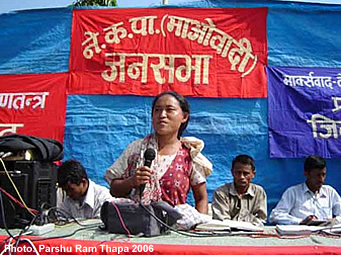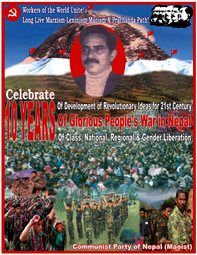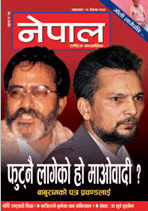|
Facts
on the Conflict: Peace Process
|
|
An
agreement over how to disarm the rebels and control the army has been reached
|
 |
KATHMANDU,
8 Nov 2006 (IRIN)
Peace
talks between Nepal's Maoist rebels and the interim government of seven
national parties concluded on Wednesday morning after nearly five months
of negotiations aimed at ending the decade-long armed conflict, which has
killed over 14,000 people.
 |
| <<
Maoist event in Udayapur
"This
is a historic moment for all of us but there are still huge challenges
ahead of us," Maoist leader Prachanda said, speaking at a press conference
in the capital after the talks.
"The
(peace) agreement has proved that all problems can be solved in a peaceful
way," Nepali Prime Minister Girija Prasad Koirala said.
An
agreement has reportedly now been reached even on contentious issues like
management of arms and the fate of the monarchy, both of which had been
responsible for delaying the talks for months. |
|
According
to the mutual agreement, all rebel combatants will be quartered in five
cantonments in the districts of Kavre, Kailala, Rolpa, Surkhet, Palpa and
Sindhuli in west Nepal, 400 km west of the capital. In addition, their
arms and ammunitions are to be securely stored in the camps under lock
and key.
 |
| <<
Maoist poster
A
special committee will be formed under the new interim cabinet to monitor,
reintegrate and rehabilitate rebel combatants.
Simultaneously,
the army will be confined to barracks and guarantee that they will not
use arms. Their weapons will also be stored under lock and key, according
to the agreement. The armed forces, formerly loyal to the king, will be
controlled, managed and mobilised by the new interim cabinet, which will
also have the power to downsize the army.
With
regard to political institutions, there has been agreement to complete
the interim constitution by 21 November, establish an interim legislature
to replace the current Nepalese parliament by 21 November and form an interim
cabinet by 1 December. |
|
The
Maoists had been waging an armed rebellion against the Nepalese state since
1996, despite two rounds of peace talks in 2001 and 2003 designed to end
the conflict.
 |
| <<
Maoist rebels' top leaders : CPN (M) chairman Prachanda und Baburam Bhattarai
But
in April, following the end of absolute rule by the monarch, King Gyanendra,
due in part to widespread uprisings led by an alliance of seven main parties
and the Maoists, a new interim government was formed and a new peace process
began.
The
two negotiating teams said agreement had been reached on how to halt disappearances
- a regular fear for civilians caught in the conflict - and on the return
of internally displaced persons (IDPs).
Elections
for the constituent assembly will be held by mid-June 2007. |
|
According
to the agreement, the assembly elections will be based on a mixed electoral
system for a total of 425 members. The United Nations has been requested
by both sides to monitor the elections.
Finally,
Nepalese people hope both sides have finally put down the gun, an ideal
the rebels appear to subscribe to, but with a rider: "Violence is never
the solution and this is the reason why we have reached an historical truce,
but we will not let the country fail as it did during past governments,"
said Prachanda.
top
Credit
IRIN 2006
Copyright
© UN Office for the Coordination of Humanitarian Affairs 2006
[
This report does not necessarily reflect the views of the United Nations]
Integrated
Regional Information Networks (IRIN), part of the UN Office for the Coordination
of Humanitarian Affairs (OCHA).
top

|






